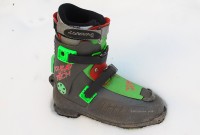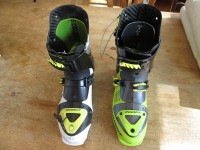The twining of business competition and overzealous marketing often engenders an “over promise and under deliver” atmosphere. We see that in various brands. We get frustrated. Example, after countless re-designs and in-line fixes, it is no secret the Dynafit has struggled with making their bindings reliable, while other brands have ramped things up to levels of competition that were hard to imagine just a few years ago. Even so, huge numbers of skiers are perfectly happy with their Dynafit bindings, and credit where credit is due, Dynafit works hard to fix their mistakes. But let’s move beyond bindings — it is really about so much more. In nearly every ski touring equipment category, Dynafit has been what clearly overall is the most influential brand. My thoughts:
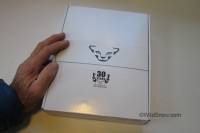
The white box with Dynafit logo could be called pretentious — we think it works. Click images to enlarge. Your opinions?
5. First and still only company to be completely ski touring vertical with branded and bona fide “self designed” bindings, boots, skis, and clothing.
The earth shook (just kidding) about 10 years ago when Salewa hired Reiner Gerstner as Brand Manager (or is that “Band” Manager? Only those on the inside know for sure).
Reiner managed a “rebranding” of the entire concern. He spearheaded development of the snow leopard logo, as well as helping focus the “Dynafit” brand on what was fast becoming a large worldwide market for ski touring gear.
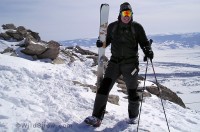
Reiner Gerstner during his visit to Jackson Hole in March of 2006, when we first met and he proposed that I ramp up my blog coverage of Dynafit by beginning a regular series of visits to Europe to experience the ski touring culture.
The road was rocky after the re-branding, with Dynafit nearly going under a few years later, saved not only by the faith of parent company Salewa, but by the double digit growth of ski touring worldwide, combined with Dynafit’s willingness to embrace and innovate lightweight-fast everything. You can joke about weight fanaticism all day long, but the fact of the matter is people who do muscle powered sports like trimming grams, and their wallets follow.
4. Brought European ski touring culture to North America in numerous ways.
During ancient history, Dynafit was still distributed in the U.S. by a Jackson Hole company known as Life-Link. A smart guy named Tim Kelley did marketing for Life-Link, and helped navigate the transition to Dynafit having a stand-alone North American distributor (Salewa N.A.).
Tim had huge influence on North American ski culture. For a few years starting in 2006, he helped Dynafit in Europe host a “Press Event” that invited a few North American journalists over to the old country to experience the roots of ski touring. Myself included. A good part of our success here at Wildsnow is the result of Tim getting us over there the first time and having our eyes opened to a “total” view of backcountry skiing. After years of being a North American ski mountaineer and sometimes feeling like I was swimming upstream, after a few hours dipped in Alps ski culture I felt like I’d come to my roots. I brought those feelings home, and so did many others.
3. In the early days, stepped up to develop and retail the tech binding, when other binding companies just rolled their eyes.
Some of the funniest stories about “Dynafit” bindings are those told by inventor Fritz Barthel, regarding how companies such as Silvretta rejected his design. “…Our inspection has led us to the decision that there would not be satisfactory acceptance for a binding of its kind at this time…” 1986 from a company that shall remain nameless. The Barthel family went on to mortgaging their own home to finance the binding as well as a stock of Dynafit boots they modified in their basement to fit the bindings. Dynafit eventually saw the light and licensed the patent from Fritz. Hence the ongoing brand — but more importantly, the finances and willingness to keep improving the binding through quite a few years when no one else was making a tech binding of any significance.
2. Made it ok to brand gear as 100% ski touring.
Dynafit’s core culture comes from individuals such as Fritz, who ski tours incessantly all winter long in the Alps surrounding Kitzbuhel and Innsbruck, and General Manager “Bene” Bohm, who’s out there on 8,000 meter peaks along with ski touring his beloved home mountains any chance he gets. I don’t see this changing. While the company does segue into the “freeride” market, where they’re consistently successful is in catering to the “pure” ski touring population. We’re not as big a group as resort and sidecountry skiers, but then, how big a company does Dynafit need to become? In my view, ski touring will keep expanding at a reasonable rate. Perhaps in single digits, but enough to sustain a well managed company.
1. Developed the first premium low volume lightweight but stiff “modern” ski touring boots, beginning with TLT5.
Since most of the Barthel binding patents expired some years ago, every season a few more “tech” bindings pop up out of the primordial ooze of ski touring product development. Some are quite nice. Virtually all are “copies” to some degree, but just as a Salomon binding could be accused of “copying” the now ubiquitous mechanics of most alpine bindings, the Dynafit “tech” binding has become the same thing; a de facto standard. That’s where the corporate culture of Dynafit must accept the inevitable: Improving the tech binding is a noble endeavor, but reality bites. It’s not exactly easy to significantly improve something that’s a well accepted commodity.
Enter, ski boots. The footwear journey was rough for the Snow Leopard. Before 1996 the only tech compatible boots you could get were those from the Dynafit boot company. The famous “red boot” was quite light. Also, it was quite flexible. But it worked and was a revolution for skiers with the technical savvy to handle it.
Around 1995, Dynafit launched their Dynafit Tourlite Tech 3. The 3 was slightly stiffer than the “Red” and more easily modified, but it was still fairly traditional what with a standard DIN shaped sole and wimpy flex.
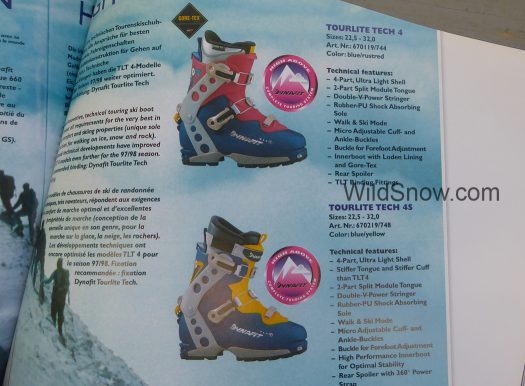
Dynafit TLT 4 ski boot was ground breaking, with trimmed toe and significant weight savings, retailed around 1996.
In 1996, presumably after Kneissl acquired the Dynafit brand they launched the disruptive TLT 4 boot. Those things were cool. Truncated toe, exoskel, superlight and fit in a way you could alpine climb in them as well as ski. Well, sort of ski, anyhow. A good skier could get results with the TLT 4, but a combination of low cuff height and overall flexible materials asked quite a bit from the rider. Whatever, the things were radical. Guys climbed 8,000 meter peaks in them.
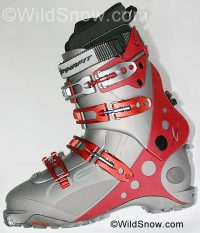
Dynafit Aero ski touring boot was an early attempt at touring boot with better downhill performance. Credit to the attempt, but it didn’t quite get there.
Then in 2005 along came the Aero. Clearly, Dynafit spent a lot of money on a series of molds and tried to do what was doubtless the precursor to modern tech compatible “freeride touring” beef boots, but with an unforgiving flex, finicky walk-ski mode, and an odd fit. The concept was good, but ahead of its time and not well executed. Time for a change.
I would have liked to be a fly on the wall at Salewa, around 2006. One can imagine confused conversations like “what do ski tourers really want in a boot?” Enter Italy. To cut the confusion Dynafit hired a creative and talented product line manager from Italy, Federico Sbrissa. At the time, “Fede” was not a hardcore skier, but he was a good listener and had his ear to the highly developed Italian ski touring culture — where the importance of “lightness” and “flexibility” had been inculcated into the very fabric of the sport by what was now a long history of ski mountaineering racing.
As is the wont of any savvy equipment company: if a race venu exists, make a product for it. So Fede did, and Dynafit came out with the Dy.N.A. in 2009. This was a low volume boot made of a rigid plastic that could be molded thinner (though doing so was a challenge that required some injection molding tech savvy). Harkening back to the TLT 4, the Dy.N.A. ignored boot sole dimension standards with a trimmed toe that walked better and shed a few more grams. It didn’t have a plastic tongue, relying entirely on the stiffness of the cuff for beef in downhill mode. (While this was introduced as a race boot, you could tell the idea was to use racing as a point-of-entry into the consumer market.)
The press event intro of the Dy.N.A. is now legend. All us journalists were gaping like a bunch of 17-year-old boys watching Baywatch for the first time. Someone got past their lustful daze, raised their hand and asked, “how much?” Fede, with the confidence and verbal inflection of a true Italian business man, spoke only one word: “mille.”
Ground breaking. The $1,000 price point for a mainstream consumer ski boot had just been broached by none other than a small ski touring equipment brand. Bold is an understatement.
TLT 5 boot was released the next year; being a more general consumer version of the Dy.N.A., with a removable tongue and different liner options. After a few years in production, the TLT 5 and subsequently TLT 6 boots became wildly popular.
After those heady boot innovative years starting in 2009, everything changed. The landscape of ski touring culture and gear is now amazingly robust. We can thank the story of Dynafit for much of that.
(Please note, some of the product dates above may be staggered a year or so, due to when a product is introduced and when it actually goes to retail. The gist of everything seems to work so I didn’t get crazy with trying to accurize that, if anyone wants more info or wants to clarify, please make comments. A more personal story of my involvement with Dynafit over the years.
WildSnow.com publisher emeritus and founder Lou (Louis Dawson) has a 50+ years career in climbing, backcountry skiing and ski mountaineering. He was the first person in history to ski down all 54 Colorado 14,000-foot peaks, has authored numerous books about about backcountry skiing, and has skied from the summit of Denali in Alaska, North America’s highest mountain.

